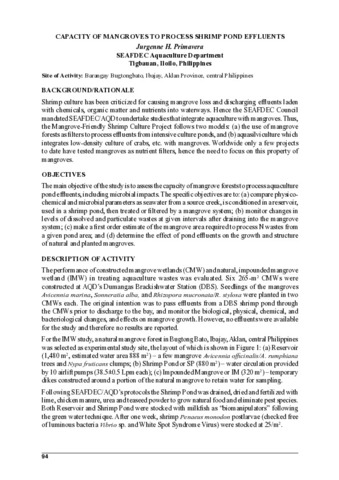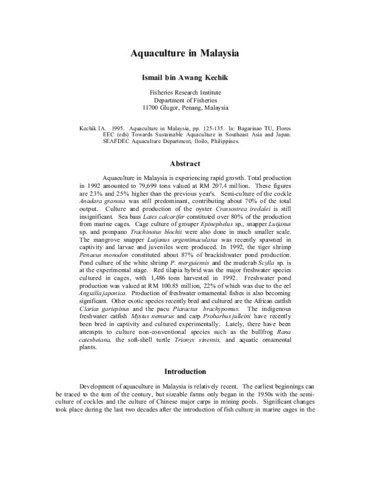Capacity of mangroves to process shrimp pond effluents.
- Global styles
- MLA
- Vancouver
- Elsevier - Harvard
- APA
- Help
Share
Abstract
Shrimp culture has been criticized for causing mangrove loss and discharging effluents laden with chemicals, organic matter and nutrients into waterways. Hence the SEAFDEC Council mandated SEAFDEC/AQD to undertake studies that integrate aquaculture with mangroves. Thus, the Mangrove-Friendly Shrimp Culture Project follows two models: (a) the use of mangrove forests as filters to process effluents from intensive culture ponds, and (b) aquasilviculture which integrates low-density culture of crabs, etc. with mangroves. Worldwide only a few projects to date have tested mangroves as nutrient filters, hence the need to focus on this property of mangroves.
Suggested Citation
Primavera, J. H. (2004). Capacity of mangroves to process shrimp pond effluents. In Promotion of mangrove-friendly shrimp aquaculture in Southeast Asia (pp. 94-103). Tigbauan, Iloilo, Philippines: Aquaculture Department, Southeast Asian Fisheries Development Center.
Type
Meeting report
Related items
Showing items related by title, author, creator and subject.
-
Aquaculture industry profile and trends
Yap, Wilfredo G. (University of the Philippines Aquaculture Society, Inc., 2001) -
Aquaculture in Malaysia
Kechik, Ismail bin Awang. (Aquaculture Department, Southeast Asian Fisheries Development Center, 1995)Aquaculture in Malaysia is experiencing rapid growth. Total production in 1992 amounted to 79,699 tons valued at RM 207.4 million. These figures are 23% and 25% higher than the previous year's. Semi-culture of the cockle ... -
Coastal aquaculture in Thailand
Sahavacharin, Songchai (Aquaculture Department, Southeast Asian Fisheries Development Center, 1995)Coastal aquaculture in Thailand has expanded rapidly in both area and production in the last decade. The important cultured species are the shrimps (Penaeus monodon and P. merguiensis), sea bass Lates calcarifer, groupers ...







